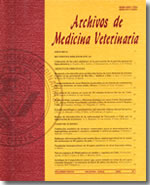Transfer factor acting as IFN-γ and IL-2 mRNA expression inductor in chicken vaccinated against avian influenza
Main Article Content
Abstract
Avian influenza is a disease of paramount economical importance for the poultry industry. In Mexico, only low pathogenicity H5N2 strain has been reported and it is controlled through inactivated-virus inoculation. This emulsified vaccine reduces clinical signs indeed, but not viral shedding. Over the last 50 years Transfer Factor (TF) has shown to be an efficient immunomodulator and has been used successfully in human clinical cases, and less commonly in animal models. The aim of this work was to establish an avian influenza-specific TF dose able to produce the highest percentage of mRNA expression of the following cytokines: IL-2 and IFN-γ. An experiment to show the mRNA expression of these cytokines in chicken previously inoculated with avian influenza-specific TF was set up. In the first experiment 0.1, 1 and 10 TF units were inoculated into 3 different groups of chickens; PCR for cytokines from splenic tissue was performed. For the second experiment, a second TF inoculation in combination with the vaccine was carried out using 3 new groups of chicken. Experiment 1: Only IL-2 expression was achieved in 58.33% of chickens using 1 TF unit (P < 0.05). In experiment 2, 75% of chickens showed IL-2 with 1 TF unit (P < 0.05) and all of them (100%) expressed IFN-γ (P < 0.01). From these results it can be concluded that IFN-γ and IL-2 expression can be induced by the inoculation of 1 TF unit (equivalent to 7.3 μg of protein) at the beginning of the experiment procedure and after a second inoculation of TF (10 days after) together with the inactivated virus vaccine.

